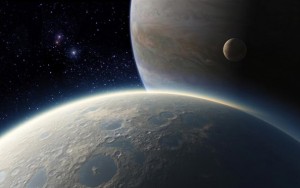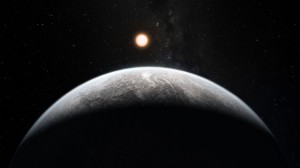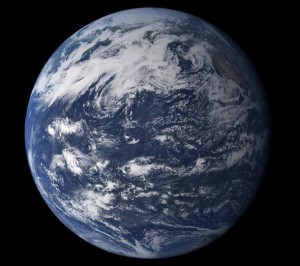A paper has been accepted for publication in a science journal (PDF) where the author has analyzed data from NASA’s Kepler planet-finding observatory, trying to figure out how many Earth-sized planets there might be in the galaxy orbiting their stars in their habitable zones; that is, at the right distance so that the star warms the planet enough to have liquid water. In the paper, he estimates that on average 34% (+/-14%) of Sun-like stars have terrestrial planets in that Goldilocks zone.
34%!
 I can explain how he got this number. But I can also explain why I think this needs to be taken with a grain of salt. Let me be clear: it’s possible he’s right, and I suspect he may very well be. His math looks good to me. But a couple of assumptions he had to make need to be pointed out, and I want that to be clear before the media start running around saying there are billions of Earths in the galaxy based on this.
I can explain how he got this number. But I can also explain why I think this needs to be taken with a grain of salt. Let me be clear: it’s possible he’s right, and I suspect he may very well be. His math looks good to me. But a couple of assumptions he had to make need to be pointed out, and I want that to be clear before the media start running around saying there are billions of Earths in the galaxy based on this.
Here’s the deal. Kepler is an orbiting observatory that’s staring at about 100,000 stars, looking for dips in their light when an orbiting planet passes in front of them from our perspective. The length of time the dip takes gives us the orbital period of the planet, and the size of the planet (if the star’s size is known, generally true) can be determined by how much light is blocked. I talk about how this works in a little more detail in an earlier post.
The astronomer, Wesley Traub of Caltech, based his analysis on only the first few months (136 days) of Kepler data, what was available at the time. This introduces a bias into the calculations, because that length of time is too short to conclusively find planets in their stars’ habitable zones! Even being generous, the length of such an orbit is at least 200 days, much longer than the Kepler sample. So he was forced to look at only short-period planets (with periods of 42 days or less), much closer to their stars, and extrapolate the data from there. I’ll note that Dr. Traub was up front about potential biases in the data and his analysis.
He looked at stars similar to the Sun (with a range from somewhat hotter to somewhat cooler, roughly F, G, and K stars). He then looked at data for all planets detected – terrestrials (Earth-sized), ice giants (like Uranus and Neptune), and gas giants (like Jupiter), getting their size and orbital period.
 Then he found the ratio of terrestrial planets to all the planets seen. Again, remember, this ratio was found for planets somewhat close in to their stars.
Then he found the ratio of terrestrial planets to all the planets seen. Again, remember, this ratio was found for planets somewhat close in to their stars.
Then he plotted all the planets versus distance from their parent stars. For example, you see very few planets very close to the star (probably because it’s hard to form or get a planet to orbit that close in), then more as you get farther out, then fewer at some large distance (which may, once again, simply be due to the fact that planets with long orbital periods can’t be seen in the short duration of the data). He then found an equation (called a mathematical fit) that did a good job predicting the shape of the plot. Once he had that, it’s easy enough to extrapolate it out to the distance of the habitable zones of the stars.
That gave him an estimate of all planets orbiting there, including gas and ice giants. Multiply by the ratio of terrestrial planets, and boom! 34% of stars like the Sun should have planets that are Earth-sized orbiting them at the right distance.
The thing that makes me most uncomfortable is that he had to use those short period planets, and extrapolate outwards. Extrapolation is always dangerous because you can’t be sure your fit behaves well outside the range in which you calculated it. For example, imagine you took a census of 1000 people ages 0 - 17, and made a fit to their height versus age. You’d find their height gets bigger with time, in general. But if you extrapolate that out to someone who is 40 years old, you might estimate they’ll be 4 meters tall!
We don’t know very well how planets form in their solar systems, and how they move around after. It may be that nature doesn’t make many planets in the habitable zone. Or maybe it does, but after some amount of time the planets move out of it, maybe through gravitational interactions with other planets. I’ll note that our own solar system makes that seem unlikely; we do have three planets in the Sun’s HZ!
 So what are we to make of all this? I think Dr. Traub did careful, interesting work, and his number of 34% is probably not terribly far off. Again, we should keep our eyes on that number, since it’s based on extrapolation, but the calculation that went into it is well-reasoned. I wouldn’t be surprised if he’s pretty close to the mark.
So what are we to make of all this? I think Dr. Traub did careful, interesting work, and his number of 34% is probably not terribly far off. Again, we should keep our eyes on that number, since it’s based on extrapolation, but the calculation that went into it is well-reasoned. I wouldn’t be surprised if he’s pretty close to the mark.
And what does this mean for you, the science enthusiast? Well, F, G, and K stars comprise very roughly a quarter of the stars in the Milky Way, or something like 50 billion stars total (again, I’m being really rough here). That means, assuming Traub is correct, there could be 15 billion warm terrestrial planets in our galaxy alone!
Interestingly, last year I wrote about how another estimate indicated that 1/4 of Sun-like stars might have Earth-like planets. That’s not far from Traub’s ratio, and that 2010 study used different techniques on different stars! Not conclusive, but interesting.
I’ll add that I think this work was worth doing even this early on in the Kepler mission. This is a great first step in analyzing the massive amount of Kepler data, and putting a number on it that we really want to know. As time goes on, and Kepler sends back more observations, Traub’s work will have paved the way to work on planets with bigger orbits. I’ll be very, very curious to see which way that number moves as more data come in.
Image credit: Dan Durda; ESO/M. Kornmesser; NASA. Tip o’ the dew shield to Technology Review.
Related posts:
- Two exoplanets discovered by “citizen scientists”
- Motherlode of potential planets found: more than 1200 alien worlds!
- Kepler finds a mini solar system!
- How many habitable planets are there in the galaxy?